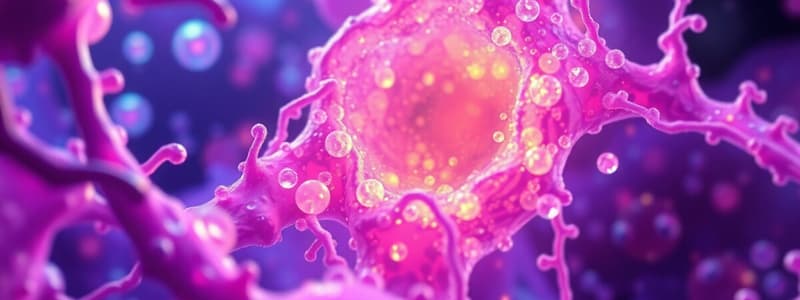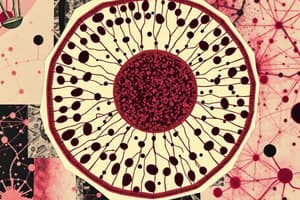Podcast
Questions and Answers
What is cytology primarily concerned with?
What is cytology primarily concerned with?
Which cytological technique is essential for visualizing cells?
Which cytological technique is essential for visualizing cells?
What is the purpose of immunohistochemistry (IHC) in cytology?
What is the purpose of immunohistochemistry (IHC) in cytology?
How does fine needle aspiration (FNA) contribute to cytological techniques?
How does fine needle aspiration (FNA) contribute to cytological techniques?
Signup and view all the answers
What is a primary application of cytology in medicine?
What is a primary application of cytology in medicine?
Signup and view all the answers
What is the primary purpose of cytology in infectious disease diagnosis?
What is the primary purpose of cytology in infectious disease diagnosis?
Signup and view all the answers
Which type of cells are responsible for covering body surfaces and cavities?
Which type of cells are responsible for covering body surfaces and cavities?
Signup and view all the answers
What does cell differentiation lead to?
What does cell differentiation lead to?
Signup and view all the answers
What characterizes atypical cells?
What characterizes atypical cells?
Signup and view all the answers
Why is understanding cellular structure important in cytology?
Why is understanding cellular structure important in cytology?
Signup and view all the answers
Study Notes
Introduction to Cytology
- Cytology is the study of cells, their structure, function, and abnormalities.
- It encompasses a wide range of techniques and applications, from routine examination of cells in body fluids to advanced procedures for the diagnosis of diseases.
- The study of cells helps us understand life processes down to the lowest level, revealing specific cellular functions.
Techniques in Cytology
- Microscopy: A fundamental technique for cytological examination, using various types of microscopes (light microscopy, electron microscopy) to visualize and analyze cells. Different staining techniques enhance cellular structures and features for easier identification.
- Cell Culture: Techniques that promote cell growth from tissues or body fluids outside the organism, allowing for in-depth study under controlled conditions. This is crucial for studying cell behavior and properties in isolation or in a controlled environment.
- Immunohistochemistry (IHC): Uses antibodies to detect specific proteins or antigens within cells. This method is vital in identifying abnormal cells or determining disease types.
- Flow Cytometry: A technique for analyzing cell populations based on physical characteristics and molecular markers, quantifying different cell types, cell cycle, and apoptosis rates.
Types of Cytological Specimens
- Fine Needle Aspiration (FNA): A common method where a thin needle is used to obtain a sample of cells directly from a suspicious mass (solid or fluid-filled). It can provide rapid diagnostic information for evaluating tissue abnormalities.
- Exfoliative Cytology: Involves collecting cells that shed naturally from body surfaces, such as Pap smears for cervical cancer screening, or examining cells from urine, sputum, or other bodily fluids.
- Biopsy Specimens: Specially collected tissue samples often used in conjunction with cytology to confirm diagnoses or reveal greater detail than cell samples alone can provide. These are samples often prepared for pathological examination to analyze tissues and cells at higher resolution.
Applications in Diagnosis and Research
- Cancer Diagnosis: Cytology plays a vital role in identifying cancerous cells and distinguishing them from benign cells, helping in early detection and classification of various malignancies.
- Infectious Disease Diagnosis: Examination of cells from fluids like blood, sputum, and urine helps identify infectious agents and their effects on cells.
- Reproductive Health: Pap smears are a routine screening method to detect precancerous and cancerous cells in the cervix, crucial for early intervention.
- Research: Cytology is fundamental to research on cell biology, genetics, and other biological sciences, providing detailed information on normal and abnormal cell behavior, structure and function.
- Specialized Applications: Cytology has applications in forensic medicine, environmental monitoring, and plant sciences to study cells and their interactions in different contexts.
Principle and Importance of Cell Differentiation
- Understanding cellular differentiation—the process of specialization in cells—is crucial in cytology.
- This process affects tissue structure and cell function.
- Cell differentiation leads to different cell types with specialized functions, which are vital for tissue structure and function.
Basic Cell Types
- Epithelial Cells: Cells that line the surfaces of organs and body cavities.
- Connective Tissue Cells: Including fibroblasts, chondrocytes, and osteocytes, these cells provide support, strength, and elasticity to tissues.
- Muscle Cells: Responsible for movement and are classified into skeletal, smooth, and cardiac muscle cells.
- Nervous Cells: Neurons and glial cells are the primary components of the nervous system, transmitting information throughout the body.
Cellular Anomalies and Disease
- Atypical Cells: Cells that display morphological characteristics divergent from normal cells. These can be indicators of disease processes.
- Tumors: Uncontrolled cell growth. Different tumor types have distinct cytological features helpful in diagnosis.
- Cell Injury and Death: Cellular damage, apoptosis, and necrosis, have characteristic cytological changes.
- Inflammatory Response: Cells involved in the inflammatory response exhibit specific cytological features.
Importance of Cellular Structure
- Understanding the structure of a cell (nucleus, cytoplasm, organelles, etc.) is essential for evaluating and determining the cell's function and state of health to interpret its role within larger tissue structures.
- Cellular components reflect the cell's metabolic activity.
- Precise identification of cellular structures aids in the diagnosis of various pathologies.
Studying That Suits You
Use AI to generate personalized quizzes and flashcards to suit your learning preferences.
Description
Explore the essential techniques in cytology, focusing on the structure, function, and abnormalities of cells. This quiz covers key methods such as microscopy, cell culture, and immunohistochemistry, providing insights into how these techniques aid in the diagnosis of diseases.




